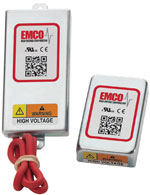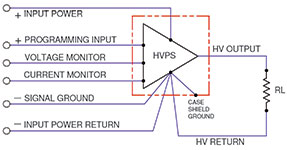
When it comes to low-intensity light detection, performance requirements often lead to selecting devices with greater sensitivity than common photodiodes or even charge coupled devices (CCDs).
Specialised detectors such as avalanche photodiodes (APDs), photomultiplier tubes (PMTs) and microchannel plates (MCPs) are often employed for these more precise applications. High-sensitivity devices bring with them a set of electronic design considerations needed to maximise the performance potential of the system.
Applications requiring sensitive light detection include spectroscopy, radiation detection, night vision, laser rangefinders, long-range fibre-optic telecommunication, blood analysers, positron emission tomography and particle physics, to name but a few.
These devices convert incoming light into an electronic signal via the photoelectric effect, whereby electrons are ejected when photons strike a photosensitive surface. The photosensitive surface is frequently held at high voltage potential, usually from around 100 V up to about 6000 V depending on the device, and commonly at negative voltage potential.
An extremely small amount of incoming light results in electron flow (hence their high sensitivity) and single photon detection is possible. Even minute amounts of voltage amplitude drift, noise or instability on the photosensitive surface directly degrade the performance of the detector.
Additionally, PMTs are particularly susceptible to electromagnetic interference (EMI). Magnetic fields can influence and distort the electron paths, degrading the gain of the detector. Non-PMT electronic circuits are not immune and can also be degraded by EMI and RFI (radio frequency interference) influences. For these reasons, careful attention must be given to the electronic circuits to achieve maximum performance of the system. The nature of the high voltages involved complicates the issue.

Generating the high voltage bias is the job of the high-voltage (HV) power supply, often a small DC to high-voltage DC converter (see Figure 1). Inside the converter, incoming low-voltage DC (typically 5, 12 or 24 V) is converted into AC via an inverter, stepped up via a high-voltage transformer, then rectified and filtered back into DC (Figure 2).
Residual ripple on the high-voltage output, left over from the rectification step, is undesirable in these high-stability, low-noise applications. Magnetic and radio frequency emissions (EMI/RFI) are particularly undesirable, for the reasons outlined above. While it is true that good filtering and shielding are required to mitigate these issues, these steps can be minimised if the HV generator is designed in such a way as to minimise the generation of EMI and RFI in the first place.

With the advent of switching power supplies and their subsequent dominance in the marketplace, along came the issue of more hard-switching noise and interference. Square-wave switching generates high peak currents and harmonics, which produce interference at high frequencies. These frequencies are often difficult to filter and shield, especially in compact systems where the presence of high voltage complicates matters.
Additionally, because of the need for high withstanding voltage, high-voltage transformers tend to exhibit high parasitic elements, especially capacitance, and can be a major source of radiated RFI and EMI.
Parasitic elements inherent in high-voltage transformers result in a narrowband resonant frequency with a high Q factor. This resonant frequency can change from device to device, and with changes in loading, input voltage, output voltage and temperature.
A frequency mismatch between a fixed-frequency, pulse-width modulated (PWM) drive signal and the natural resonant frequency of the transformer results in high current spikes, stresses and high transient voltages. For these reasons, switching-type topologies are undesirable in noise-sensitive environments, such as low-intensity light detection.
A more desirable topology that avoids these drawbacks is the resonant converter, as utilised in XP Power’s range of DC to HVDC converter modules. The history of resonant circuits dates back to the 19th century. By self-resonating at the natural resonant frequency of the transformer, issues such as high current spikes, transient voltages and noisy harmonics are minimised. The adoption of this topology is particularly advantageous in low-noise applications.
Electromagnetic radiation consists of coupled electric and magnetic fields and electrostatic fields with the presence of high voltage. Additional steps available to minimise noise at the DC to HVDC converter level include the use of shielded magnetic core geometries, soft switching techniques, noise cancelling schemes, high-performance filtering and good EMI/RFI shielding.
When these elements are executed well, the high-voltage generator can be located very close to the detector, without degrading performance, while allowing for compact design packages. Locating a small, high-voltage source near the detector eliminates the need for high-voltage cabling from a large, bulky power supply.
It is important to note that commonly used plastic and aluminium enclosures perform poorly for EMI/RFI containment. Plastic, of course, has no shielding effect. Non-ferrous metals such as copper, brass and aluminium have a permeability that is the same as ‘free space,’ i.e., the relative permeability is 1. Common mild steel has a permeability of around 2000. Steel is very prone to oxidation and solderability is poor, so a plating (such as zinc) is often utilised.
Miniature high-voltage sources are commercially available that feature precise regulation, remote programmability and control, while providing live readback. Internal regulation circuitry keeps the high voltage stable, despite changes in load current, input voltage, time and temperature. This allows the high-voltage power supply to be easily integrated into the system using only low-voltage I/O signals.
Employing miniature, PC board mounted modules avoids the time, cost and risk associated with procuring a custom power supply via traditional methods, or developing one from scratch. Changes in voltage and current levels, even late in the game, can easily be made as common footprints allow for interchangeability between models.
These high-voltage modules are already being produced in volume, so reliability is proven, and new users benefit from the economies of scale when it comes to cost and lead time. Safety agency approvals are already in place, further reducing design risk and development schedules. Component-level, PC board mounted high-voltage sources are readily available via online distribution for rapid prototyping.
At the output end of the detector, a sensitive electronic amplifier circuit is deployed to provide a robust signal for further processing. These circuit elements are often shielded from EMI/RFI radiation to avoid interference and subsequent performance degradation. Special grounding techniques will minimise interference from noise generating circuits, such as power supplies.

Careful segregation of power, control and shielding grounds will reduce interference in sensitive applications such as these.
There are typically three types of ground in a high-voltage power supply system: the input power source, the low-voltage control and monitoring circuits, and the high-voltage return. These three grounds should have their own independent, dedicated current return paths and should be connected using a ‘star’ grounding technique as shown in Figure 3.
| Tel: | +27 11 454 8053 |
| Email: | sales@vepac.co.za |
| www: | www.vepac.co.za |
| Articles: | More information and articles about Vepac Electronics |

© Technews Publishing (Pty) Ltd | All Rights Reserved